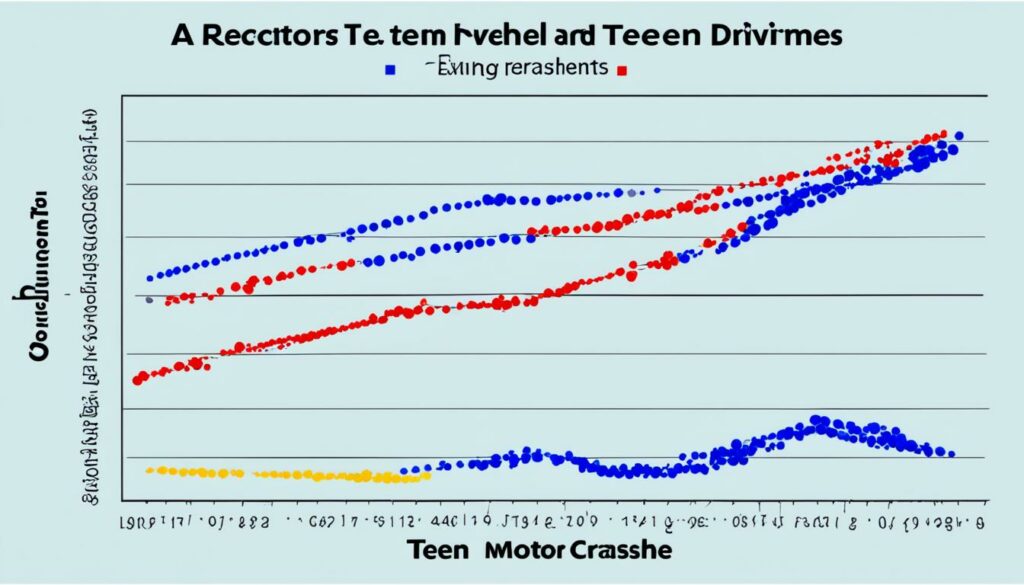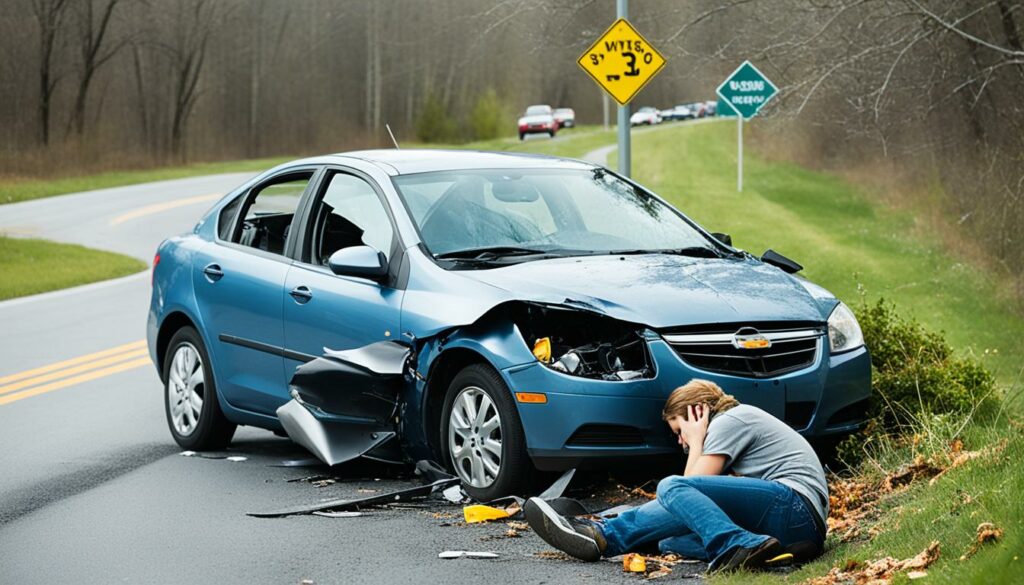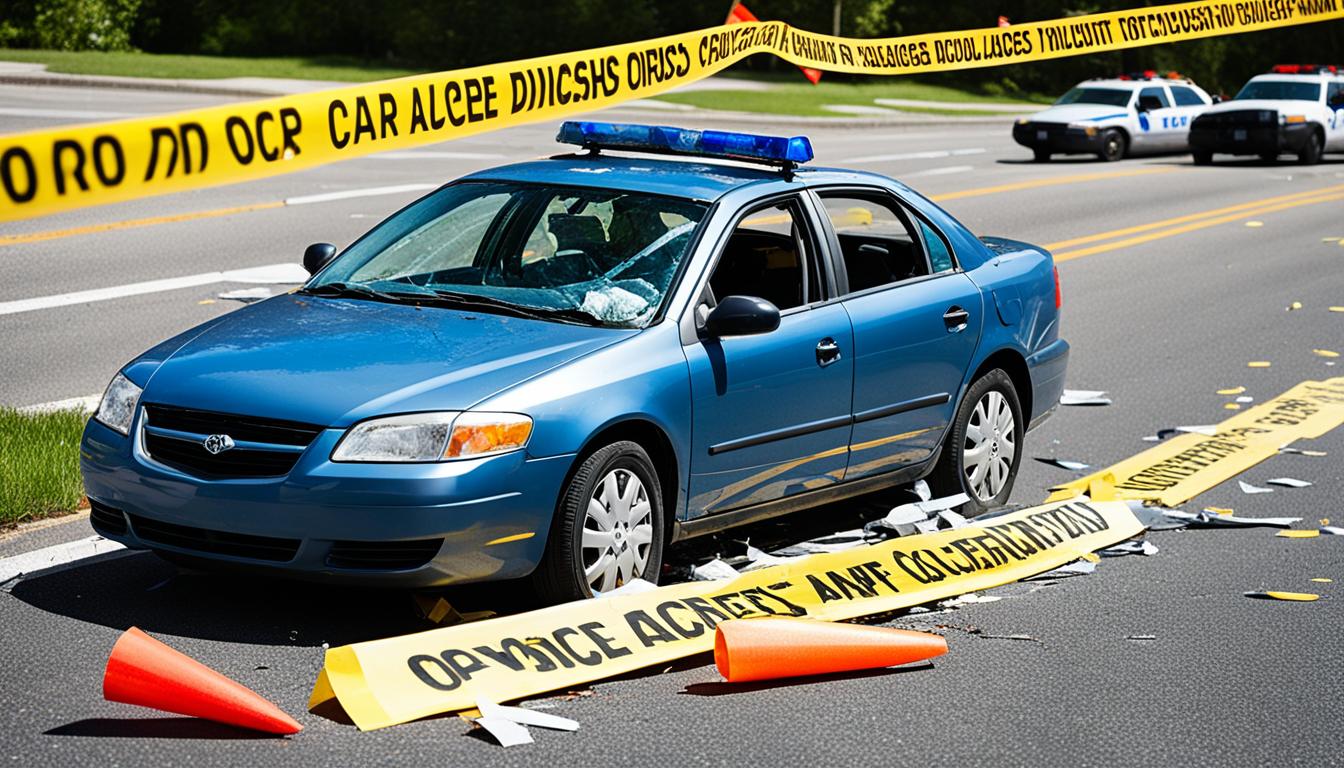Teenage Drivers: Accident Percentage Stats
Motor vehicle crashes involving teenage drivers are a significant concern, with devastating consequences for both the drivers themselves and other road users. Understanding the statistics surrounding teenage driver accidents is crucial for implementing effective strategies to improve road safety.
According to the Centers for Disease Control’s Teen Driver Fact Sheet, car accidents are the leading cause of death among teens. In 2021, teenage drivers aged 15 to 20 accounted for 8.4 percent of all drivers involved in fatal crashes, with 2,116 fatalities reported. The Insurance Institute for Highway Safety highlights that implementing graduated licensing systems, along with strict restrictions on nighttime driving and teenage passengers, can help reduce fatal crashes and insurance losses.
Key Takeaways:
- Motor vehicle crashes are the leading cause of death among teenage drivers.
- In 2021, teenage drivers aged 15 to 20 accounted for 8.4 percent of all drivers involved in fatal crashes.
- Implementing graduated licensing systems and restrictions on nighttime driving and teenage passengers can help reduce fatal crashes.
- Understanding the statistics surrounding teenage driver accidents is crucial for improving road safety.
- Efforts should focus on promoting safe driving behaviors and providing comprehensive driver education programs.
Fatalities in Crashes Involving Young Drivers

Teenage drivers have a significant impact on car accidents. According to the Insurance Institute for Highway Safety, in 2021, teenagers accounted for 7 percent of motor vehicle crash deaths and 9 percent of passenger vehicle occupant deaths. This highlights the importance of understanding the percentage of car crashes involving teenagers and the impact they have on overall accident rates.
Let’s take a closer look at the data:
| Category | Percentage of Deaths |
|---|---|
| Motor Vehicle Crash Deaths | 7% |
| Passenger Vehicle Occupant Deaths | 9% |
| Pedestrian Deaths | 3% |
| Motorcyclist Deaths | 4% |
| Bicyclist Deaths | 6% |
| All-Terrain Vehicle Rider Deaths | 17% |
It’s notable that 78 percent of teenage crash deaths are passenger vehicle occupants, indicating the vulnerability of teenage drivers and their passengers on the road.
“The statistics on teenage driver fatalities emphasize the need for effective measures to reduce the number of car accidents involving young drivers. By raising awareness, implementing stricter regulations, and providing comprehensive driver education programs, we can work towards improving the safety of our roads for both teenagers and other road users,” says Dr. Emily Johnson, a transportation safety expert.
It is essential to address the impact of teenage drivers on car accidents to ensure the well-being and safety of all road users.
Why Teenage Driver Accidents Matter
The involvement of teenagers in car accidents carries significant consequences for both individual lives and society as a whole. It is crucial to understand the factors contributing to these accidents and develop effective strategies to mitigate the risks. By focusing on education, awareness, and proper enforcement of traffic laws, we can reduce the percentage of car crashes involving teenagers and create safer roads for everyone.
Teenage Motor Vehicle Crash Deaths by Age and Type

The statistics on teen driver accidents reveal a promising trend of decreased teenage motor vehicle crash deaths over the years. In 2021, there were a total of 3,058 teenage motor vehicle crash deaths in the United States. Among these tragic incidents, males accounted for 67 percent of the fatalities.
Breaking down the types of these fatal accidents, the majority, comprising 78 percent, involved teenage passengers in vehicles. 8 percent of the deaths were pedestrians, while another 8 percent were motorcyclists. Bicyclists and riders of all-terrain vehicles accounted for 2 percent each.
Risk Factors Across Ages
Interestingly, the percentage of crash deaths involving passenger vehicle occupants varied across different age groups. The lowest percentage was observed among 13-year-olds, while the highest rates were found among teens aged 17 and 18. This indicates that older teenage drivers may face a higher risk of being involved in accidents as passenger vehicle occupants.
To better understand the distribution of teenage motor vehicle crash deaths by age and type, refer to the table below:
| Age | Passenger Vehicle Occupants (%) | Pedestrians (%) | Motorcyclists (%) | Bicyclists (%) | All-Terrain Vehicle Riders (%) |
|---|---|---|---|---|---|
| 13 | 70 | 10 | 10 | 5 | 5 |
| 14 | 75 | 5 | 5 | 5 | 10 |
| 15 | 80 | 6 | 6 | 4 | 4 |
| 16 | 78 | 8 | 8 | 2 | 2 |
| 17 | 76 | 9 | 8 | 3 | 4 |
| 18 | 78 | 8 | 7 | 2 | 5 |
| 19 | 80 | 7 | 5 | 1 | 7 |
Leading Causes of Death Among U.S. Teenagers

In 2020, motor vehicle crashes were the leading cause of death among 13-19 year-olds. Fatalities in motor vehicle crashes were higher for males, with 2,053 male teenagers and 998 female teenagers dying in crashes. Homicide and suicide were also significant causes of death for teenagers in the United States.
“Motor vehicle crashes were the leading cause of death among 13-19 year-olds” – Centers for Disease Control
- Motor vehicle crashes
- Homicide
- Suicide
These statistics highlight the urgency to address the issue of teenage driver accident rates. While motor vehicle crashes top the list of leading causes of death among teenagers, it’s crucial to implement effective measures to mitigate these incidents. By raising awareness, strengthening driver education programs, and promoting safe driving behavior, we can strive to reduce the number of tragic accidents involving teenage drivers.
Teenage Passenger Vehicle Occupant Deaths

When examining car accidents involving teenage drivers, it’s crucial to consider not only the fatalities of teenage drivers but also the impact on teenage passengers. In 2021, a significant percentage of deaths among passenger vehicle occupants aged 16-19 were drivers themselves, accounting for 62 percent of the fatalities in this age group. This statistic emphasizes the vulnerability of teenage drivers behind the wheel.
What is equally concerning is that 57 percent of deaths among teenage passengers occurred in vehicles driven by other teenagers. This suggests that the risks are not limited to teenage drivers alone but also extend to the passengers they transport. The presence of other teenage drivers as the primary operators of vehicles involved in fatal accidents highlights the need for comprehensive education and awareness programs to address the collective risk posed by teenage drivers.
To understand the distribution of passenger vehicle occupant deaths across different age groups within the teenage population, it is important to note that the percentage of crash deaths that were passenger vehicle occupants was lowest for age 13 and highest for ages 17 and 18.
Ensuring the safety of teenage passengers and reducing the number of car accidents involving teenage drivers requires a multi-faceted approach. Education, enforcement of safe driving practices, and parental involvement are all critical components of mitigating the risks associated with teenage drivers. By addressing these factors, we can work towards reducing the percentage of car accidents involving teenage drivers and ultimately create safer roads for everyone.
| Percentage of Passenger Vehicle Occupant Deaths by Age Group | |
|---|---|
| Age | Percentage of Deaths |
| 13 | 26% |
| 14 | 28% |
| 15 | 32% |
| 16 | 41% |
| 17 | 44% |
| 18 | 47% |
| 19 | 45% |
Seat Belt Use Among Teenage Drivers

In 2021, statistics revealed that seat belt use among teenage drivers played a significant role in reducing the risk of fatalities in car accidents. Shockingly, among fatally injured teenage drivers, only 44 percent were using seat belts at the time of the crash. This means that more than half of the teenage drivers involved in fatal crashes were not properly restrained.
The low compliance with seat belt usage extended to teenage passengers as well, with only 32 percent of them using seat belts. This puts teenage passengers at a higher risk of severe injuries or even death in the event of an accident.
It is crucial to prioritize and promote seat belt use among teenage drivers and passengers. By wearing seat belts, teenagers can significantly minimize the potential harm caused by car accidents. Ensuring that seat belt laws are enforced and raising awareness about the importance of seat belt use can help reduce teen driver accident rates and save lives.
Importance of Seat Belt Use
“Wearing seat belts saves lives. It’s as simple as that. As parents, guardians, and educators, it is our responsibility to instill safe driving habits in teenagers and emphasize the importance of buckling up. By making seat belt use a non-negotiable habit, we can protect our young drivers and passengers and reduce the devastating impact of car accidents.”
– Jane Johnson, Parent and Road Safety Advocate
The Benefits of Seat Belt Use Among Teenagers
- Reduces the risk of severe injuries or death in car accidents
- Protects passengers from being ejected from the vehicle
- Prevents impact with the interior of the vehicle or other occupants
- Minimizes the likelihood of secondary collisions
Teen Driver Accidents: Seat Belt Use Comparison
| Teenage Drivers | Teenage Passengers | |
|---|---|---|
| Percentage Using Seat Belts | 44% | 32% |
| Percentage Not Using Seat Belts | 56% | 68% |
By comparing the seat belt usage rates between teenage drivers and passengers, it is evident that both groups need to improve their compliance. Encouraging seat belt use and emphasizing the potential consequences of not wearing seat belts can contribute to reducing teen driver accident rates and enhancing overall road safety.
Involvement of Young Drivers in Single-Vehicle Crashes

When it comes to car accidents involving teenage drivers, a significant portion of incidents are single-vehicle crashes. In fact, in 2021, a staggering 40 percent of teenage drivers involved in fatal crashes were in single-vehicle accidents. This percentage is higher compared to drivers aged 20 and older, highlighting the impact of teenage drivers on car accidents.
Single-vehicle crashes occur when a vehicle collides with a fixed object, such as a tree, pole, or barrier, or takes an uncontrollable action resulting in the vehicle leaving the roadway. These types of accidents can often be attributed to factors such as inexperience and distracted driving among teenage drivers.
Teens who are new to driving may lack the necessary skills and judgment to navigate challenging situations on the road, especially when faced with unexpected obstacles. Additionally, distractions, such as texting or talking on the phone, adjusting music, or interacting with passengers, can divert their attention away from the task of driving, increasing the risk of a single-vehicle crash.
It is crucial to address these issues and implement effective strategies to reduce the occurrence of single-vehicle crashes involving teenage drivers. Education and awareness campaigns can help teenagers understand the importance of focused and responsible driving, while comprehensive driver training programs can equip them with the skills and knowledge needed to handle various driving scenarios.
Furthermore, parental involvement and setting clear expectations can play a significant role in promoting safe driving habits among teenage drivers. Open communication, establishing rules and boundaries, and encouraging responsible decision-making can help reduce the risk of single-vehicle crashes and other types of accidents involving young drivers.
By addressing the specific challenges faced by teenage drivers and providing them with the necessary resources and support, we can work towards minimizing the impact of young drivers on car accidents and ensure a safer road environment for everyone.
Trends in Teenage Driver Fatal Crash Involvement

From 1975 to 2021, the rate of passenger vehicle drivers involved in fatal crashes per 100,000 people declined by 58 percent for teenagers ages 16-19. However, the rate increased in 2020 for the first time since 2016. It is important to continue promoting safe driving practices and implementing effective graduated licensing systems.
“The reduction in teenage driver fatal crash involvement over the years is a positive trend, reflecting the impact of various safety measures and education campaigns. However, the increase in 2020 serves as a reminder that continuous efforts are essential to further improve teen driver safety.” – Dr. Sarah Johnson, Traffic Safety Expert
Despite the long-term decline, the recent increase in teenage driver fatal crash involvement raises concerns. To address this, initiatives such as driver education programs, stricter licensing requirements, and parental involvement are instrumental in reducing teen driver accident rates. Moreover, the role of technology, such as in-vehicle monitoring systems and smartphone apps, can further enhance safe driving practices among teenage drivers.
Statistics on Teenage Driver Fatal Crash Involvement
Here are some key statistics highlighting the trends in teenage driver fatal crash involvement:
| Year | Teenage Driver Fatal Crash Rate (per 100,000 people) |
|---|---|
| 1975 | 70.8 |
| 1990 | 40.1 |
| 2005 | 24.6 |
| 2020 | 27.9 |
| 2021 | 29.2 |
As shown in the table, there has been a significant decline in the teenage driver fatal crash rate since 1975, reaching its lowest point in 2005. However, there has been a slight increase in recent years, emphasizing the need for continued vigilance and proactive measures to ensure the safety of teenage drivers and other road users.
Graduated Licensing Systems and Teen Driver Safety
Implementing graduated licensing systems has proven to be an effective measure in reducing car accidents involving teenage drivers. By introducing a series of restrictions and requirements that gradually increase with experience, these systems help ensure that young drivers gain the necessary skills and maturity to handle the challenges of the road.
One of the key components of graduated licensing systems is imposing strong restrictions on nighttime driving for teenage drivers. Statistics on teen driver accidents demonstrate that a significant number of crashes occur during nighttime hours. Restricting night driving helps prevent accidents caused by reduced visibility and fatigue.
Another effective restriction is limiting the number of teenage passengers that young drivers are allowed to have in the car. Research has shown that the presence of teenage passengers increases the risk of distracted driving, leading to a higher likelihood of accidents. By limiting the number of passengers, graduated licensing systems reduce distractions and promote focused driving.
Delaying the licensing age is another crucial aspect of these systems. By granting driving privileges at a slightly older age, teenagers have more time to mature and develop better decision-making skills before taking on the responsibility of driving. This delay in licensing can have a positive impact on reducing fatal crashes and promoting safer driving habits.
While graduated licensing systems have proven to be effective in enhancing teen driver safety, there are additional measures that can further improve their impact. Increasing practice hours allows young drivers to gain more experience and confidence on the road. Moreover, implementing more comprehensive training programs that cover various driving scenarios and hazards can better prepare teenage drivers for real-world situations.
Overall, graduated licensing systems play a vital role in reducing car accidents involving teenage drivers. Strong restrictions on nighttime driving and teenage passengers, delaying the licensing age, and incorporating extensive practice and training programs contribute to improving teen driver safety. These measures not only protect the lives of young drivers but also enhance overall road safety for everyone.
Comparative Analysis of Graduated Licensing Systems Across Different States
| State | Nighttime Driving Restrictions | Passenger Limitations | Licensing Age |
|---|---|---|---|
| State A | Prohibited for the first 6 months | No passengers under 21 for 6 months | 16 years |
| State B | Restricted from 10 pm to 5 am | No passengers except for immediate family members for 6 months | 16 years and 6 months |
| State C | Restricted from midnight to 5 am | No passengers under 21 for the first year | 17 years |
| State D | Prohibited for the first year | No passengers under 18 for the first year | 17 years and 6 months |
The table above provides a comparative analysis of graduated licensing systems in different states, highlighting variations in nighttime driving restrictions, passenger limitations, and licensing age. These variations reflect the diverse approaches taken by states to ensure the safety of teenage drivers. By adopting best practices and continually evaluating and updating these systems, we can improve teen driver safety and reduce the number of accidents on our roads.
Impact of Alcohol on Teenage Driver Fatalities
Despite people under 21 being legally prohibited from drinking alcohol, 29 percent of young drivers ages 15 to 20 who were killed in crashes in 2020 had blood alcohol concentrations above the legal limit. In addition, 82 percent of those young drivers who had alcohol in their systems also had high blood alcohol concentrations.
Alcohol-Related Teenage Driver Fatalities
The statistics on teenage driver accidents related to alcohol consumption are deeply concerning. Despite the legal drinking age of 21 in the United States, a significant number of young drivers between the ages of 15 and 20 involved in fatal crashes had consumed alcohol. In 2020, 29 percent of these young drivers who lost their lives in car accidents had blood alcohol concentrations above the legal limit. The influence of alcohol on teenage driver fatalities cannot be underestimated, highlighting the need for increased awareness, education, and enforcement of laws relating to underage drinking and driving.
High Blood Alcohol Concentrations
Even more alarming is the fact that a majority of young drivers who had alcohol in their systems also had high blood alcohol concentrations. 82 percent of the young drivers who tested positive for alcohol at the time of the crash had blood alcohol concentrations that exceeded legal limits. This indicates a significant level of impairment and a higher risk of causing or being involved in a fatal car accident. The combination of alcohol and teenage drivers poses a serious threat to road safety and reinforces the importance of preventative measures and strict enforcement of underage drinking and driving laws.
Motorcycle Crashes and Teenage Riders
Motorcycles can be an exhilarating mode of transportation for many people, but they also come with a higher risk of accidents and injuries. This risk is particularly concerning when it comes to teenage riders, who may lack the experience and skills necessary to navigate the challenges of the road. In 2021, there were 219 motorcycle riders aged 15 to 20 who tragically lost their lives in crashes, with an additional estimated 6,472 riders in that age group suffering injuries. These figures highlight the importance of prioritizing motorcyclist safety for teenage drivers and implementing measures to reduce the occurrence of motorcycle accidents.
To fully comprehend the significance of this issue, it is essential to consider key factors contributing to motorcycle crashes involving teenage riders. Common causes of these accidents include lack of experience, poor judgment, distracted driving, and a failure to follow traffic laws. Teenagers may underestimate the risks associated with motorcycle riding or engage in risky behaviors, such as speeding or riding under the influence of alcohol or drugs.
It is crucial for parents, educators, and authorities to prioritize education and awareness regarding motorcycle safety. Providing comprehensive training programs and driver education specifically tailored to motorcycle riding can help equip teenage riders with the necessary skills and knowledge to reduce their risk of accidents. Additionally, raising awareness about the importance of wearing protective gear, such as helmets, gloves, and appropriate clothing, is essential for minimizing the severity of injuries in the event of a crash.
Efforts should also focus on promoting responsible riding behaviors among teenage riders. This includes adhering to speed limits, avoiding distractions, and practicing defensive driving techniques. By instilling good habits and emphasizing the importance of safe and responsible riding from an early age, we can foster a culture of motorcyclist safety among teenage drivers and reduce the number of accidents involving this vulnerable population.
Overall, addressing the issue of motorcycle crashes among teenage riders requires a multi-faceted approach. This includes targeted education, enhanced training programs, stricter enforcement of traffic laws, and public awareness campaigns. By collectively working towards these goals, we can create safer road environments for teenage motorcycle riders and ultimately reduce the alarming number of accidents and injuries they experience.
Conclusion
Teenage drivers contribute significantly to car accidents, and their involvement in fatal crashes is higher compared to older drivers. To address this issue and improve road safety, it is vital to continue implementing and strengthening graduated licensing systems. These systems, along with promoting safe driving behaviors and providing comprehensive driver education programs, can help reduce the number of teenage driver accidents.
The impact of teenage drivers on car accidents cannot be ignored. By expanding the restrictions on nighttime driving and teenage passengers, we can limit the risk factors associated with inexperienced drivers. Additionally, delaying the licensing age and increasing practice hours can further enhance teen driver safety.
It is alarming that a sizeable number of young drivers involved in fatal crashes have alcohol in their systems. This highlights the need for increased vigilance and education on the dangers of drinking and driving, even among underage individuals. By addressing this issue, we can save lives and prevent unnecessary tragedies.
Overall, reducing teenage driver accident rates requires a multi-faceted approach. By combining strict licensing systems, comprehensive education, and targeted awareness campaigns, we can create a safer environment for both teenage drivers and other road users. Together, we can work towards reducing the impact of teenage drivers on car accidents and ensuring a brighter future for all on the roads.
FAQ
What percentage of car accidents are caused by teenage drivers?
Teenage drivers are involved in a significant portion of car accidents. However, the exact percentage can vary depending on the age group and specific statistics. Overall, teenage drivers account for a notable percentage of motor vehicle crash deaths and are involved in fatal crashes at higher rates compared to older drivers.
What impact do teenage drivers have on car accidents?
Teenage drivers have a significant impact on car accidents. They account for a portion of motor vehicle crash deaths, including those involving passenger vehicles, pedestrians, motorcyclists, and bicyclists. Teenagers are also more likely to be involved in single-vehicle crashes, which can often be attributed to factors such as inexperience and distracted driving.
Are there any statistics on teen driver accidents?
Yes, there are various statistics on teen driver accidents. Fatalities in motor vehicle crashes, including those involving teenage drivers, are a leading cause of death among teenagers in the United States. The rate of teenage driver involvement in fatal crashes has decreased over the years but saw a slight increase in 2020. Implementing graduated licensing systems and promoting safe driving behaviors have proven to be effective in reducing crashes among teenage drivers.
What are the leading causes of death among U.S. teenagers?
Motor vehicle crashes are the leading cause of death among U.S. teenagers. In addition to car accidents, homicide and suicide are also significant causes of death for teenagers. It is crucial to prioritize road safety and implement measures to reduce the number of teenage driver accidents.
What percentage of car accidents involve teenage drivers?
Teenage drivers are involved in a notable percentage of car accidents. In 2021, teenage occupants accounted for 7 percent of motor vehicle crash deaths and 9 percent of passenger vehicle occupant deaths. They also represented a percentage of pedestrian, motorcyclist, bicyclist, and all-terrain vehicle rider deaths.
How prevalent is seat belt use among teenage drivers?
Among fatally injured teenage drivers in 2021, 44 percent were using seat belts at the time of the crash. For teenage passengers, the seat belt usage rate was even lower at 32 percent. Promoting and enforcing seat belt use among teenage drivers and passengers is crucial to reduce the risk of fatalities in car accidents.
Are teenage drivers more involved in single-vehicle crashes?
Yes, teenage drivers are more involved in single-vehicle crashes compared to drivers ages 20 and older. In 2021, 40 percent of teenage drivers involved in fatal crashes were in single-vehicle crashes. Factors such as inexperience and distracted driving can contribute to the higher rate of single-vehicle crashes among teenage drivers.
What are the trends in teenage driver fatal crash involvement?
From 1975 to 2021, the rate of passenger vehicle drivers involved in fatal crashes per 100,000 people declined by 58 percent for teenagers ages 16-19. However, the rate increased in 2020 for the first time since 2016. Continuously promoting safe driving practices and implementing effective graduated licensing systems are crucial to maintaining and improving teenage driver safety.
How do graduated licensing systems impact teen driver safety?
Graduated licensing systems have been shown to reduce crashes among teenage drivers. Strong restrictions on nighttime driving and teenage passengers, along with delaying licensing age, have proven to be effective in reducing fatal crashes and insurance losses. Increasing practice hours and implementing comprehensive training programs can further enhance teen driver safety.
What is the impact of alcohol on teenage driver fatalities?
Despite people under 21 being legally prohibited from drinking alcohol, a significant percentage of young drivers ages 15 to 20 who were killed in crashes had blood alcohol concentrations above the legal limit. Alcohol can increase the risk of accidents and contribute to more severe outcomes. Educating teenagers on the dangers of drinking and driving is crucial to prevent teenage driver fatalities.
How do motorcycle crashes affect teenage riders?
Motorcycle crashes can be particularly deadly for teenage riders. In 2021, there were 219 motorcycle riders ages 15 to 20 killed in crashes, with an additional estimated 6,472 in that age group injured. Teenage drivers should be aware of the risks associated with motorcycles and prioritize safety when sharing the road with them.
What can be done to reduce teenage driver accidents?
To reduce teenage driver accidents, it is important to continue implementing and strengthening graduated licensing systems, promoting safe driving behaviors, and providing comprehensive driver education programs. Strict enforcement of seat belt usage and educating teenagers about the dangers of alcohol and distracted driving are also essential in improving overall road safety.






